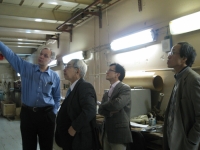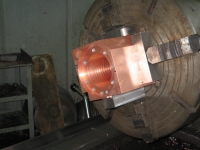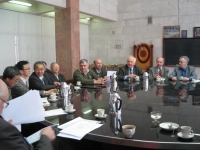 |
 |
|||||||||||||
|
|||||||||||||
|
|||||||||||||
The baseline design for the International Linear Collider (ILC) positron source is based on multi-MeV photons that produce pairs in a metallic target. The photons are created by the main electron beam passing through a helical undulator. The conventional method, positron generation via pair production using an electron beam, which is used as the positron source in all existing accelerators in the world, is adopted however as an alternative technology in the Baseline Configuration Document (BCD). If the method of using fixed metal targets is adopted for the ILC design, the abundant number of positrons would cause an excessive temperature rise and melt the targets. This is a challenge that ILC scientists face to find an appropriate approach for this thermal breakdown phenomenon of the metal target, and to clear the technical difficulties to develop an extremely high-speed spinning target to prevent it. These challenges would still remain to some degree in undulator-based methods too. As a solution, Pavel Logatchev of the Budka Institute of Nuclear Physics (BINP) suggests positron production using a liquid metal target. On 18 March, Masao Kuriki (KEK), an expert of particle sources, visited BINP and discussed the general status of the liquid metal target, the possibility of using it in the ILC and collaborative research. There are some issues in using a liquid metal target. For example, ensuring the reliability of equipment is a concern, such as liquid metal containers, pipes for sending liquid metal, and pumps for the cyclical process. Logatchev's group already proved the high reliability of the equipment through prototyping and having a continuously running test over the course of one year. Another challenge is the tolerance of the liquid metal. Scientists will need to conduct a number of tests in the electron beam to prove that it will work. If successful, scientists might be able to use liquid metal not only for the positron generation by electron beam for the ILC, but also for the positron generation by gamma rays, such as an undulator or Compton scattering. In the U.S., Cornell University has also been studying liquid metal targets. The flux concentrator, a special magnet to produce an intense magnetic field in order to focus the positrons generated in the positron source, was another topic of discussion during the visit. The flux concentrator is considered to improve the production efficiency of the positron beam, and it could be a placeholder of the simple electric solenoid magnet with coil. When a flux concentrator produces an intense magnetic field, it will receive strong stress itself and may break. Many tests are currently underway. “The flux concentrator can be a candidate for the ILC's positron source, depending on the result of test,” said Kuriki. BINP is the only laboratory pushing forward R&D of the flux concentrator at this time. As part of the visit, BINP Director Alexander N. Skrinsky, BINP Deputy Director Gennady N. Kulipanov, and many researchers discussed these and other topics over coffee and lunch, the traditional way for BINP to discuss topics with the management and researchers. Kuriki who participated in the lunch discussion said, “It was a valuable experience. I think these table talks are the birthplace of the unique ideas of BINP.” -- Nobuko Kobayashi |
|||||||||||||
| © International Linear Collider |


